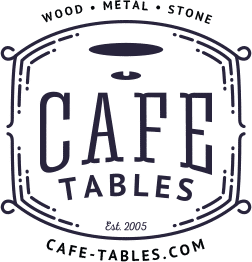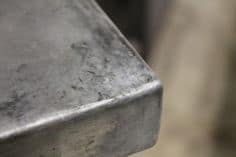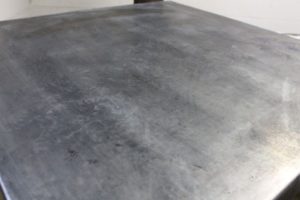How to Care for Your Zinc Table Top
Zinc Properties and What to expect:
Zinc is a natural mineral that is anti-fungal and antibacterial. Zinc is non-porous so all tarnish spots are only on the surface level and can be removed by polishing or buffing. Zinc and copper are reactive metals that will continue to age over time. Oils, acids, and even standing water will change the surface. Over time the spots and other patina marks will run together so that each top is a unique and beautiful piece. Zinc will oxidize to a darker metallic color while copper will turn brown. Heavy use areas will be smooth and lighter in color.
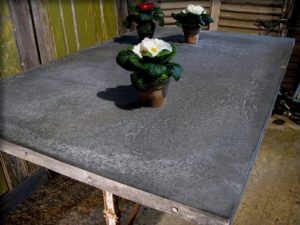
Appearance:
There are three main types of finishes for zinc table tops: polished, matte, or patina. Only the initial appearance of the table differs. It is still likely that the zinc will react in the same way.
- Polished: Very shiny and reflective. The patina will form the slowest in this finish because the surface is smooth and less porous, therefore resulting in a slower reaction. However, zinc is a soft metal and the polished surface will show scratches.
- Matte: The most common finish. This finish helps the zinc react to everything from fingerprints to tap water. This is the best finish for an aged look without a separate patina process.
- Patina: Uses acid to create a reaction on the surface of the zinc. Many reactive agents create a darker color on the zinc and the new reactions will blend into the already aged look of the patina finish.
Cleaning and Maintenance:
Simple everyday cleaning can be done with a sponge or soft towel and a non-acidic dish soap. If a cleaner contains citric acid, ammonia, or other harsh chemicals, it may cause unwanted aging or spotting on the zinc. Occasionally using the abrasive side of the sponge can be helpful for removing built up oxidation that forms naturally on the zinc over time. Zinc is a reactive metal, therefore it is important to remember that it can be clean and still have spots on it. If you would like to remove the spots read on about how to polish your table top.
To clean up spots on a zinc table top there are a few methods. Start by using a lemon and salt water mixture or vinegar and salt. If the stain persists, resort to Brasso and buffing. This will change the color of the table and restore the original look to the table top. We find that a scotch pad on a buffer followed by 0000 steel wool worked just as well to remove any tarnish and provide shine.
This process will be lengthy and labor intensive so we do recommend assessing the area to be worked on before jumping in. We do not recommend polishing if a patina has been added to the zinc. Please call with any concerns or questions (864) 659-0809 or email [email protected].
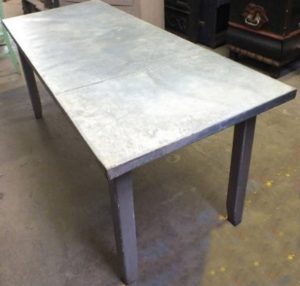
Heavy cleaning to return to original finish:
Supplies needed:
Scotch pad
0000 steel wool (if polished surface is desired)*
Dust mask
Orbital sander
Clean cotton cloth
Beeswax or lemon pledge (if desired)
Cleaning instructions:
- Wear the dust mask to keep from breathing in any zinc dust or use a little water with the scotch pad.
- Use the scotch pad on the orbital sander, just like if it were a sanding pad.
- Run the sander over the entire surface of the table top until you achieve the clean look you are hoping for. You may have to replace the scotch pad if working on a large table. You can also use a 220 grit sand paper for heavy removal, but you will need to follow with the scotch pad. The scotch pad will provide a nice satin finish.
- *Use the 0000 steel wool next, if polished surface is desired.*
- Wipe off table top with soft cloth to remove any zinc dust that may have settled.
- (Optional) Apply wax or furniture polish for shine.
